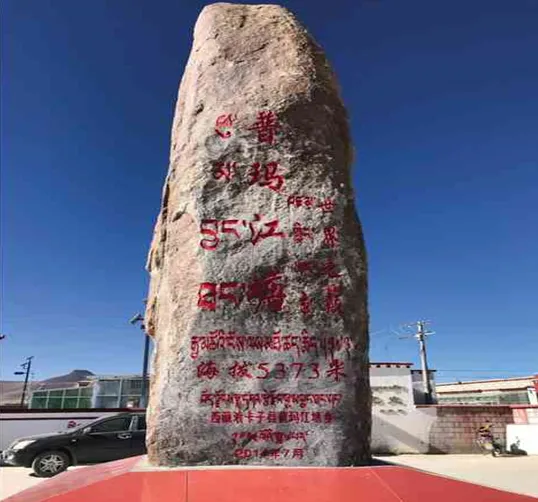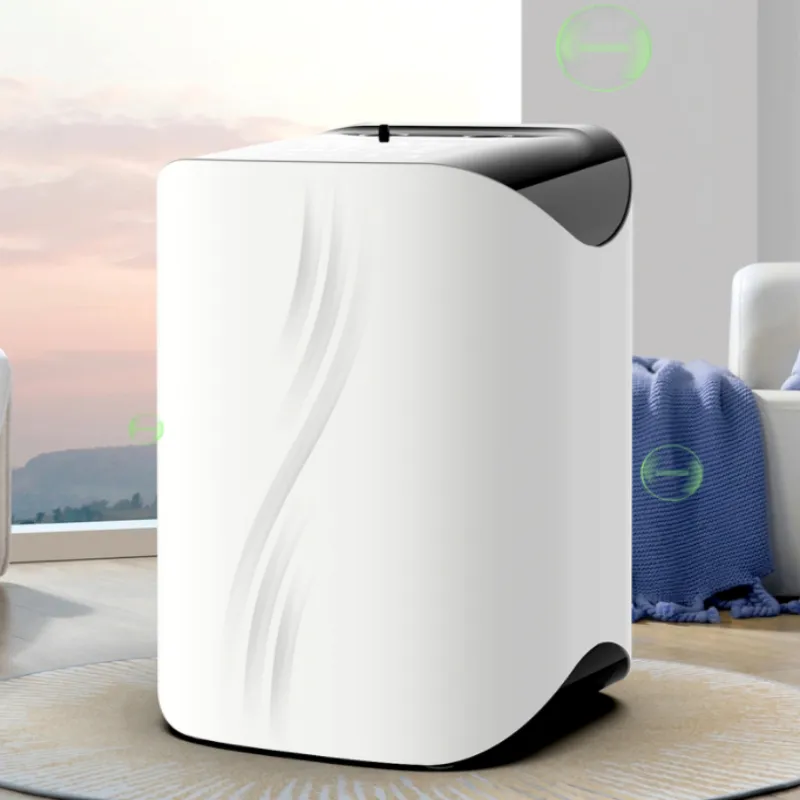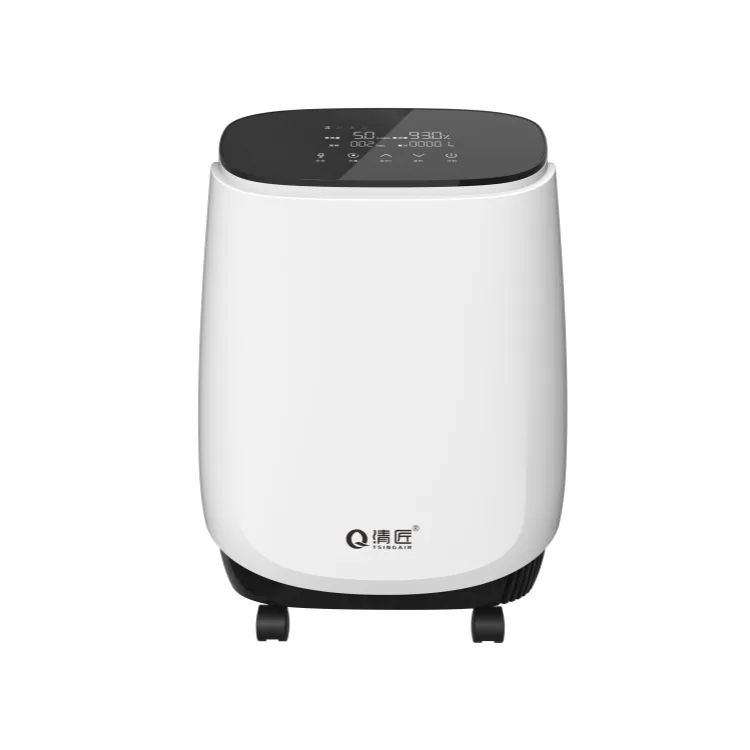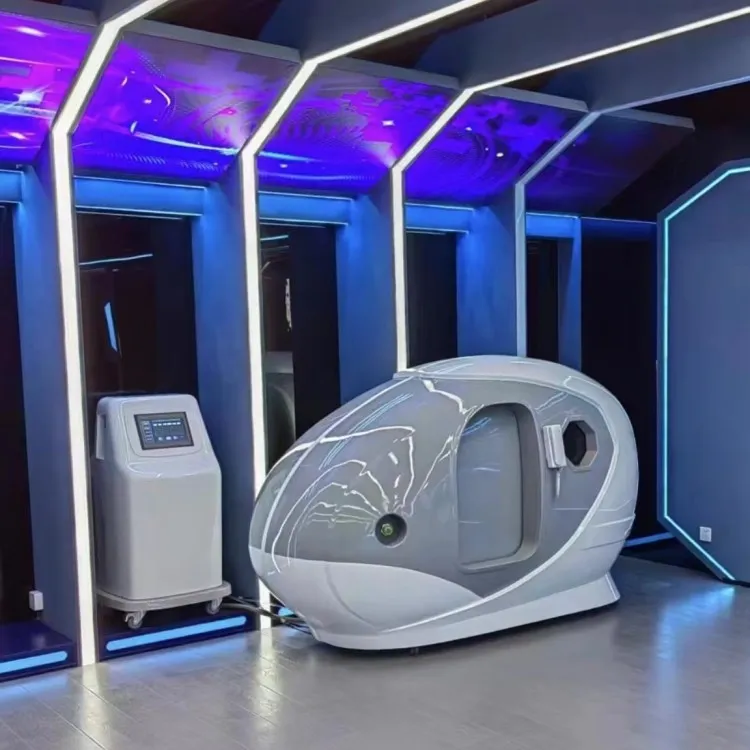
Oxygen is the first element to maintain life and health. Slight lack of oxygen slowly damage human organs and shorten life expectancy. People living on the Tibetan plateau suffer from different degrees of oxygen deficiency, and the higher the altitude, the more serious the oxygen deficiency, the more serious the damage, and the shorter the life expectancy. Life expectancy per capita in Tibet continues to rank the bottom of the country, currently lower than the national average of about 8 years; the higher the altitude within the Tibetan region, the shorter the life expectancy, high altitude township Puma Jiangtang township per capita life expectancy of less than fifty years; Yunnan, Qinghai, Guizhou ranked the second to fourth from the bottom of the country, are not unrelated to this. Severe hypoxia quickly endanger life, people die in 6 minutes of oxygen deprivation. In patients with neoconiosis, the alveolar epithelium is edematous, oxygen crosses with difficulty, and the CT image of the lung is a ground glass shadow or even a continuous piece of “white lung”, resulting in severe hypoxia. At this time, if not with effective life support measures, only anti-inflammatory treatment is likely to be too late. This is the case in patients with highland pulmonary edema, without high-flow oxygen therapy, death can occur in a few days or even hours, which is extremely dangerous.

I compared the practice in this anti-epidemic with my experience in solving the problem of hypoxia in my aid to Tibet and found that the lack of positive attitude towards oxygen use and the lack of experience in oxygen therapy are widespread and are the shortcomings of our public health management and complete chain of preventive-clinical-rehabilitation medical system. We would like to take this opportunity to write an article, suggesting that we should learn from the experience of Tibetan aid and lessons learned in the fight against epidemic, scientifically “oxygen” ourselves, popularize the knowledge of “oxygen” and the methods of using oxygen to our families and people around us, and raise health awareness.
I. Delay in oxygen therapy measures in the fight against epidemic
From January 11 to 22, 2020, a 70-year-old couple in Wuhan were successively infected with the new crown pneumonia. The wife was hospitalized for 3 days and then the husband was unable to stay in the hospital. The doctor thought of a way to give the wife prescribed oxygen therapy treatment. That night, the husband lay next to his wife in the hospital bed rubbing oxygen, thought he could not survive that night, but waited for the dawn. The symptoms were significantly reduced, and after a few hours, the fever went down.

On January 26, 2020, the first day of the Lunar New Year, the Guangdong medical team took over Hankow Hospital. The hospital had 80 patients with new crown pneumonia, including 50 critically ill patients. After taking over, through many efforts, the Guangdong medical team obtained a batch of oxygen machines and oxygen cylinders to implement high-flow oxygen therapy for patients. Dr. Chen Ailan said, “More than three deaths per day before the takeover, high-flow oxygen therapy, many patients’ blood oxygen saturation rose from 40%, 50%, 60% to more than 95%, and the number of deaths per day dropped to 0-1.” Why doesn’t Hankow Hospital itself do oxygen therapy in the morning? Is there a problem with the oxygen source? Wuhan has one of the most famous gas companies in Asia! I immediately contacted WMG. Old colleagues told me that the gas company has been mobilized to produce at full capacity, medical oxygen supply Wuhan is more than enough, but also in support of the province and Central China. WISCO’s slogan is: I would rather have a lack of oxygen in the blast furnace than a lack of oxygen in the hospital. The central enterprise! Oxygen source is no problem. That is the problem of rescue and treatment guidelines.

On February 5, 2020, the National Health Commission released the fifth edition of the “New Coronary Pneumonia Treatment Program”, which added mandatory “oxygen therapy” to the treatment of severe and critically ill cases, stipulating that “heavy patients should receive nasal catheter or mask oxygenation. High-flow nasal catheter oxygen therapy or non-invasive mechanical ventilation.” Previously released on January 27, the fourth edition, January 23, the third edition of the “treatment of heavy, critical cases” section did not have this provision, only in the “general treatment” section has “timely and effective oxygen therapy Only in the section of “general treatment”, there is a provision of “timely and effective oxygen therapy”.
The doctor, the Hankow Hospital, the Health and Welfare Commission, effective practice conduction faster, the “treatment plan” oxygen therapy mandatory measures to be introduced earlier how good. I say this without a trace of complaint. China’s anti-epidemic measures are effective worldwide, and the performance of China’s medical workers is the first in the world, and people all over the world can see that I personally admire it. But experience costs money and time, but the price paid by others and the experience accumulated elsewhere is also a price and experience! The new crown pneumonia outbreak tested that we are not active in the use of oxygen, the lack of experience in oxygen therapy, the shortcomings of the family is not widespread is relatively obvious, both in the medical system and in the family need to make up. Professor Xiao Pingtian of Xiangya Hospital, deputy director of the hyperbaric branch of the Chinese Medical Association, recently said: In 2003 I proposed to use hyperbaric oxygen to treat SARS, when some experts thought it was difficult to cross-infection barrier, did not use, and did not try. Today the civilian hyperbaric oxygen chamber has matured, I hope that the conditions of the unit to strive for the application.
Second, people in life do not pay attention to the camp “oxygen”
Oxygen concept into China in 1850, the Qing Dynasty scientists, China’s modern chemical enlightenment Xu Shou (1818.2-1884.9) will be named “nourishing gas”, the Commercial Press in 1920 to add the word gas on the head of the word “nourishing” to create the word “oxygen”. Oxygen is nourishing qi, the qi of nourishing health, and the camp “oxygen” is nutrition. The enlightened hint clear, the modern concept confused.
The first element of life and health is oxygen, but the seven nutrients of the human body do not include oxygen, they are: water, protein, carbohydrates, fat, vitamins, minerals and cellulose. If the camp “oxygen” indicator Z intuitive is blood oxygen saturation (SpO2%), people generally unfamiliar, home can have more expensive blood pressure meter, blood glucose meter, but not a hundred dollars a blood oxygen meter.
Although anyone has to breathe all the time and eat every day, may not understand that adults breathe 12 to 15kg of air a day, which is as much as three times the total mass of meals 3 to 5kg! The general emphasis on the three meals a day nutrition, ignoring the breathing camp “oxygen” should be equally important. Such as the installation of a new air system is still a minority of families, northern families do not protect the room for children to write homework, indoor air quality is poorer in the season when ventilation is not possible, while the developed countries began to popularize 60 years ago. Another example is the occurrence of physiological hypoxia lips cyanosis when the elders at home are older, and the younger generations do not know how to measure blood oxygen and suck oxygen to the elderly. The possibility of buying oxygen machines is far behind air purifiers.
Although most people have travel experience by air but do not necessarily have scientific experience, few people realize that each flight is a low-altitude “plateau” line, not necessarily the correct response, or even no response concept. The cabin altitude (also known as cabin pressure altitude) of the civil aircraft in those few hours of cruise at 10,000 meters is 2200 ~ 2400 meters, higher than Kunming, lower than or equal to Xining, the air is 24% ~ 26% thinner than the plain (see “Altitude and Atmospheric Pressure Comparison Table”), the body may be insufficient oxygen supply (90% ≤ SpO2 < 95%) or hypoxia (SpO2 < 90%) mild hypertension. It’s not hard to monitor and eliminate, you can see the data in a few seconds with an oximeter clipped to your finger, if it’s below 95%, it’s happening, abdominal breathing can be elevated in half a minute, keep doing it consistently without hypoxia. But I bet the people reading this article for the first time basically did not measure blood oxygen while flying (except for Tibetan Airlines flight attendants).
A short period of mild hypoxia is not life-threatening, and you can still not measure or do it in the future if it’s too much trouble, as many people, including you, have done before, and it seems to be nothing. However, the lack of oxygen to human health damage is the end of life to calculate the total account. What is “accounting”? You can talk to the Tibetan aid cadres around you, their reaction speed and memory in the middle of life “Tibet” station to settle accounts once.
The actual fact is that you will be able to get a lot more than just a few of the most effective and most effective and most effective.
People in Tibet generally lack of oxygen. The average altitude of Tibet is 4,000 meters, the air is 44% thinner than the plain, regardless of men, women and children Tibetan Han Chinese hereditary short live generally lack of oxygen. on March 4, 2014, I measured the pulse and blood oxygen saturation for 26 Tibetan preschool children and a teacher in the village of Nagqu, the results were an average of 87.4%, in a state of hypoxia. on a certain day in September 2016, in a parking lot at an altitude of 5,100 meters, a Tibetan boy had an oxygen saturation of only 77% to 80% and was severely hypoxic. Instances are endless and exist all the time. It is a misconception to think that Tibetans have lived in Tibet for generations to adapt and not be hypoxic. Tibetans have been living in the plateau for a long time, hypoxia compensation prompted hemoglobin to rise, blood oxygen saturation is slightly higher than the new people around the plateau, but can not change the fact that hypoxia, “plateau red” is the mark of long-term hypoxia. Tibetan ancestors migrated from the plains of humans, humans are the species of plains reproduction, it is impossible to adapt to the thin air environment of the plateau, but only at the cost of physiological hypoxia stubbornly surviving.
More lesions shorter life span. 2005 in a study, the analysis of 696 cadres physical examination data, physical examination conclusions all normal only 8 cases, individuals suffering from diseases at the same time the total number of detected Z as many as 15 kinds, the number of individuals suffering from more than 5 kinds of diseases amounted to 432 people, accounting for 62.07%. Suffering from chronic plateau heart disease accounted for more than 60%, plateau hypertension accounted for 37%, plateau erythrocytosis accounted for 51.58%, plateau cataract accounted for 54%, hyperuricemia caused by polycythemia vera, gout abound. The mortality rate of cadres and workers in the Ali region is nearly 10 times higher than the national average, and the average age of cadres in service in Anduo County of the Nagqu region who died of plateau diseases was only 42.5 years old. 4103 retired (retired) cadres died in the region from 2001 to 2008, and the average age was only 64.8 years old. The average life expectancy of Puma Jangtang Township is less than 50 years old, and no one received the “60-year-old pension insurance” stipulated by the state in 2009 for many years, until 2016 when the age was relaxed to 50 years old by special approval, and only 77 people received it in the township in 2017. Most Tibetan cadres also let their bodies “adapt” to the plateau, adapt to the lack of oxygen. Usually do not measure oxygen, oxygen deficiency does not supplement oxygen. Individual Tibetan aid cadres said: in order to be able to end Tibetan aid back to the (mainland) only insist not to inhale oxygen. The logic does not make sense, it is puzzling. The country has sent a total of nine batches of Tibet aid cadres from 1995 more than 10,000 people, of which only our seventh batch did not sacrifice people on duty, but “1513 people (including midway rotation staff) had 421 people (times) suffered from pulmonary edema, cerebral edema and other plateau diseases, 63 people were injured on duty.” The ninth batch of Tibetan aid cadres entered Tibet one after another in mid-July 2019, and unfortunately sacrificed a doctor on July 31 and a lawyer on August 4. Heaven and earth are not benevolent to all things as ruminants ah!
The wrong concept of improper measures. In the mid-19th century, French physiologist Claude Bernard overturned the traditional concept of “life adapts to the environment”. On March 4, 2014, I finished measuring 26 children in Nagqu and consulted Lhasa, whose oxygen saturation averaged 87.4%. A few days later the aid friend relayed to me, the autonomous region people’s hospital plateau department doctor said: Naqu there is 80 a few. late 2015, Rikaze city held a lecture on plateau health knowledge, the city’s people’s hospital plateau department doctor told aid cadres, in order to adapt to the plateau as soon as possible, do not inhale oxygen or less oxygen. The video of the lecture was engraved into a CD and sent to the newly arrived Tibetan aid cadres. The main medical resources in Tibet are mainly used for treating diseases and solving the problem of lack of oxygen, and few resources are used for treating diseases and solving the problem of no lack of oxygen. Generations of medical workers have made unremitting efforts to overcome the “plateau disease” problem, but I have never heard of anyone who is attacking the “plateau not disease”. Similar to “herd immunity”, patients see doctors to treat the disease, no one does not suffer from “plateau disease” prevention and science work. In fact, in addition to the unique living habits and regional water and soil caused by liver worm disease, large bone disease, cataracts, etc., there is no “plateau disease” lowlander oxygen deficiency can not, “plateau disease” from a certain point of view is a lack of oxygen disease.
Not sick is the purpose, cure is not the purpose. Human five basic physiological indicators, body temperature, pulse rate, blood pressure, respiratory rate and oxygen saturation standards are the same for all people. Note that I emphasize standards, not tolerance limits. Body temperature standards do not vary depending on whether one lives in the cold or tropical zone, and blood oxygen standards do not change depending on whether one is on a plateau or a plain. Highlanders can’t suffer unknowingly like a frog boiled in warm water because oxygen deprivation is invisible and untouchable.
I reluctantly compare “no oxygen” with “no mask”, but they are very similar. Both are simple, low cost and effective measures that cause problems when not done. Oxygen intake can avoid lack of oxygen in the body, however, people in the plateau oxygen like doing the wrong thing, itself is the oxygen-absorbing animals, oxygen intake but become embarrassed. In the plateau to persuade fellow Tibetans, Tibetan second generation, and by this ideological contagion in Tibetan cadres, Tibetan aid cadres to absorb oxygen, is a very difficult thing. Wearing a mask has also become an insurmountable wall in some European and American countries. During an epidemic outbreak, wearing a mask can block the spread of the virus, both to protect oneself and to be responsible for others. However, the reality is that not only do they refuse to wear them, but also others wear them to infringe on themselves. For example, Italian parliamentarians were ridiculed for wearing masks and slammed the microphone, Swiss female parliamentarians were expelled from a meeting for wearing masks, and American supermarket security guards were shot and killed for advising customers to wear masks. Linking physical protection with inherent culture, the behavior is stupid and the consequences are terrible.
Fourth, people in the plateau can not lack of oxygen!
Awareness makes a breakthrough. It took me two years to realize: the plateau is not lack of oxygen, the plateau air is not lack of oxygen, the plateau lack of air, people in the plateau lack of oxygen. From the end of 2013 in the village, I gradually found that “plateau lack of oxygen”, “plateau air lack of oxygen” is not valid. “In 2014, I turned on the oxygen detector switch in Lhasa, and the result showed that it was close to 21%, and I exhaled into the probe. The “21%” immediately dropped, and after a while it was back to close to 21%. Since then, I can’t say “plateau oxygen deficiency” or “plateau air oxygen deficiency” anymore. 1 cubic meter of air in space at sea level is 1.293kg, in Lhasa is 0.84kg, a 35% reduction, which is an objective environmental fact. People in the lack of air in the environment as usual breathing, the volume of inhaled air remains unchanged, but the amount of matter (moles) decreased, in Lhasa reduced by about 5kg / day, about 1/3, so people lack of oxygen, which is a fact of human physiology. The body can not produce enough energy due to lack of oxygen, so dizziness and shortness of breath, feet on cotton. The lack of oxygen in the plateau is the application of the law of indestructibility of matter, also known as the law of conservation of mass, on the human body.
Russell said: No matter what you are studying or thinking about, ask yourself only what the facts are and what the truth is that these facts confirm. Never allow yourself to be influenced by what you would prefer to believe, or think people believe, that would be more beneficial to society. Just examine, alone, what is the truth.
Practice builds experience. Not breathing as usual to solve the problem of people lacking oxygen in the plateau. From the beginning of the problem, we do not accept the cycle of “first lack of oxygen, then sickness, then treatment”, and seize the human behavior problem of “people breathe as usual” and do not let go of it, and in the “Plateau Oxygenation” left by the last group of Tibetan aid cadres (Yang Zhanqi, Higher Education Press 2013) Inspired by the last group of cadres to restore abdominal breathing, achieved immediate results. Low-flow oxygen intake during sleep at night







2 Comments. Leave new
Great!
Content for your website https://zetds.seychellesyoga.com/info